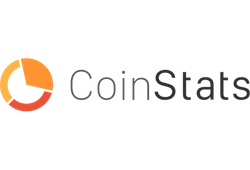
There is perhaps nothing more fundamental for a cryptocurrency trader than having a portfolio. It is the tool you turn to first to check the success of your investments and understand your financial standing. In this CoinStats review, I'll talk about one of the more notable portfolio managing services.
CoinStats is a highly specialized portfolio management tool for traders and investors that helps them track and monitor their crypto activity in a streamlined and clear way. Services of this nature are paramount to getting a good grasp on the market from your own subjective perspective. For many individuals, they are a godsend.
With this in mind, let’s take a look at this CoinStats app review, with an emphasis on all-important questions like “is CoinStats legit?”, “is CoinStats safe?” and “is CoinStats free?”. Of course, these topics just scratch the surface of my CoinStats review, as I will be delving into a plethora of areas.
Verdict at a Glance: Designed for altcoin traders utilizing diverse platforms, blockchains, and Web3 wallets, CoinStats offers an all-encompassing portfolio management platform. With support for over 100 chains, it provides diverse features and insights, enabling users to track and analyze their digital asset holdings. However, it also provides users with crypto storing, swapping, and earning possibilities.
Free Airdrop Season 7 is LIVE! Answer fun questions or do simple tasks to earn rewards from the $30K BitDegree prize pool. Participate Now ! 🔥
Pros
- Crypto, NFT, and DeFi project monitoring
- Supports over 100 chains
- Detailed analytical tools
- Built-in swap and fiat on- / off-ramp
- Earning features
Cons
- Basic account is quite limited
Table of Contents
- 1. What is CoinStats?
- 2. CoinStats Review: PROS
- 2.1. Monitor Crypto, NFTs, and DeFi Projects
- 2.2. Detailed Asset Stats and Portfolio Analytics
- 2.3. Wallet Explorer With 100+ Chain Support
- 2.4. Swap, Earn, and Buy with CoinStats Wallet
- 3. CoinStats Review: CONS
- 3.1. Basic Account is Pretty... Well, Basic
- 4. CoinStats Pricing
- 5. How to Use CoinStats? (Mobile + Browser)
- 5.1. How to Sign Up on CoinStats?
- 5.2. How to Use CoinStats Portfolio?
- 6. Conclusions
What is CoinStats?
No CoinStats review would be fair without first answering the question “what is CoinStats?”. At its core, CoinStats is a crypto investment tracker that allows you to monitor the trades you have performed and the assets you hold in a streamlined and intuitive way. You can access it on your computer, smartphone, and even a smartwatch. Though, most users tend to pick the mobile app version (you can download it here).
That being said, CoinStats does have other features that it offers that deviate from this, such as its function that allows for crypto swaps, but this is mostly an additional or extra element that compliments the main features.
One thing that you’ll notice about CoinStats is that it does a good job of keeping its aims focused. Rather than try and become a full ecosystem, attempting to be a jack of all trades but master of none, the team has chosen to stay focused on the specific goal of offering high-quality crypto portfolio tracking at the forefront.
This move is highly refreshing, especially in an age in the crypto world where it seems every company is trying to add every single feature under the sun.
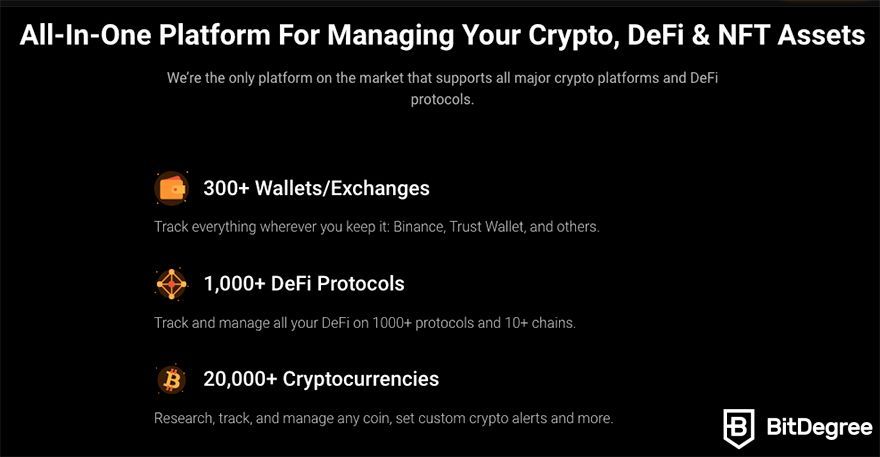
In many ways, this gives CoinStats an innovative edge, making it an outlier in all the best ways. By avoiding the trap of this, CoinStats is able to be highly interoperable, meaning that it connects to a wide array of crypto ecosystems on the market.
Thus, users can connect their trading accounts and wallets from a huge list of projects, combining all this data to offer accurate and personalized statistics.
You might now wonder, "is CoinStats safe when it comes to storing all sensitive information about my portfolio?". Well, it does employ industry-standard encryption methods and access control mechanisms to safeguard that information.
Besides, it offers additional security measures like two-factor authentication and biometric authentication. So, combining that with several user CoinStats reviews, it can be said that CoinStats is pretty safe and legit.
CoinStats Review: PROS
Let’s kick off my CoinStats review focusing on the positives. From its diverse compatibility to powerful tracking features, let's uncover the advantages that set CoinStats apart in the world of digital asset management.
Monitor Crypto, NFTs, and DeFi Projects
The name “CoinStats” might suggest that the service only works with coins and tokens, but assuming this would be a mistake. In truth, CoinStats works with practically any blockchain-based asset in existence. This means that it can work with NFTs and some DeFi projects, alongside coins and tokens. After all, it supports over 100 chains.
If you are a crypto trader who owns NFTs and other assets, then you can combine all of this data into your CoinStats portfolio for easy viewing and monitoring. In this sense, you could say that it encourages users to explore various other avenues in the industry.
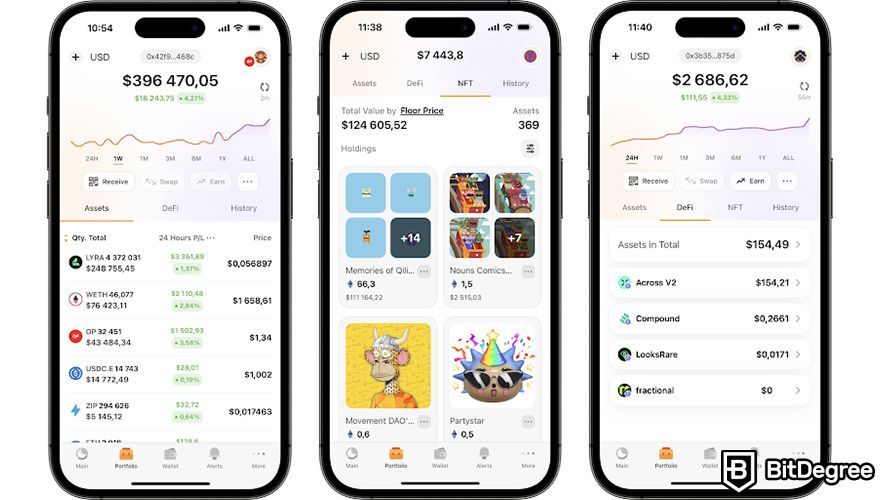
Let me explain how powerful CoinStats is with an example. With this tool, you can track your Bitcoin and Ethereum investments, your stablecoins, your NFT investments (including your fractional NFTs), and even keep an eye on tokenized stocks and yield farming tokens.
Essentially, anything that is related to the blockchain sector can be added to your portfolio. This is, therefore, a major pro that is pointed out in many CoinStats reviews.
So, if you're an investor who sticks with only one type of asset because you are disinterested in the potential hassle that would be caused by working with multiple, CoinStats might just be your lifesaver.
Detailed Asset Stats and Portfolio Analytics
Oftentimes, there is an implicit idea that if you diversify too much, you'll struggle to keep track of your investments and analyze them because it simply is very complicated[1]. This is especially the case with the blockchain space, where there is such variety. However, it should be clear that this trade-off does not exist when it comes to CoinStats.
The platform provides users with various analytical and asset insight tools that allow them to track their investments and analyze their portfolio as a whole, as well as each asset separately (no matter if it's a crypto token, an NFT, or a DeFi project).
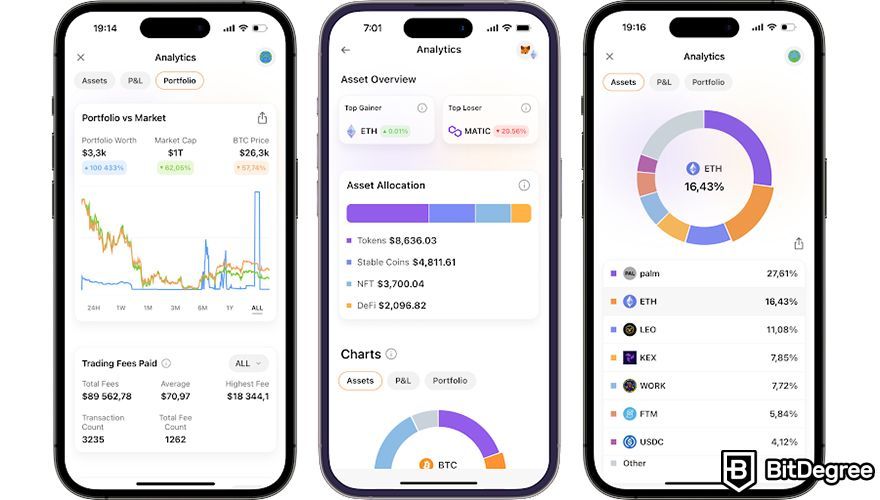
Let's take NFTs as an example. Like with all assets, there are two types of statistics that you might be interested in. There are objective stats, that focus on the overall NFT set itself and view its price changes as a whole. And, there are individual statistics for specific NFTs that you might own.
When it comes to objective stats, people tend to look for the overall health of the set from an economic standpoint. This means assessing how NFTs in the set typically sell for, and whether their prices have all been rising or falling over a period of time.
Individual stats are more for NFT owners, who have a certain asset that they want to monitor the market rate for. If it's an NFT made via generative methods, such as Bored Apes, accurately pricing them would involve not only seeing how the NFT set is doing overall, but also checking what the rate of certain features within the NFT are going for, and how rare they are.
Thankfully, after checking out several user CoinStats app reviews and trying out the app myself, I can say that it offers both types of statistics, which are accessible with ease and precision. Not only can people see the overall market value of a certain set, but they can compare that to the prices of the NFTs they own, or even take a look at specific NFTs that they might be interested in buying.
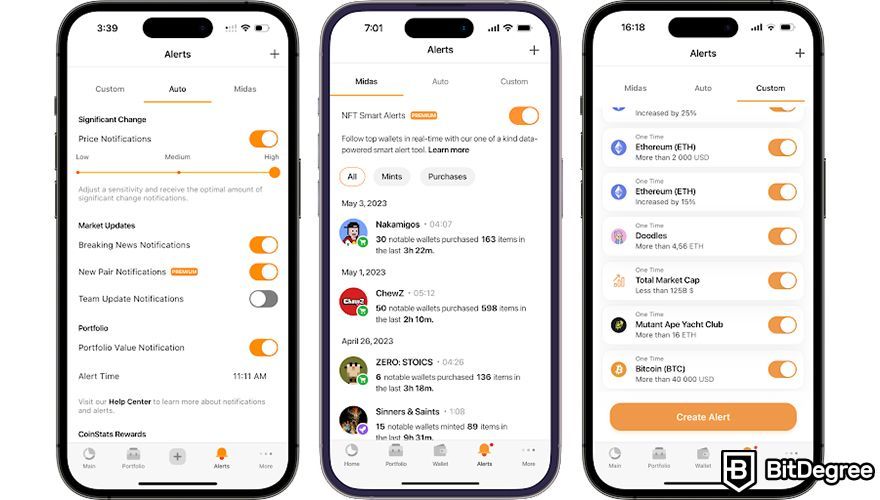
In addition to analyzing your assets, CoinStats offers a valuable feature that enhances your real-time awareness – you can set up customized smart alerts to receive timely notifications about market updates or significant NFT transactions.
This means that you'll automatically be informed if there are any changes in the prices of your chosen assets or if notable transactions, such as sales or purchases of NFTs, occur. That's surely a praise-worthy feature for any CoinStats review.
Lastly, there's the Chain Activity tool, which allows you to monitor your wallet's activity on chains with airdrop potential. You can effortlessly track transaction count, total trading volume, fees spent, and last activity. As of writing, it is compatible with chains such as zkSync Era, Starknet, and Polygon zkEVM, but it will most likely expand in the future.
In essence, the Chain Activity tool adds a layer of transparency and strategic advantage to your crypto journey. It not only keeps you informed about your wallet's current state but also positions you to capitalize on potential airdrops and other opportunities that may arise.
Latest Binance Coupon Found:Sign up on Binance and claim up to $600 worth of rewards for completing simple tasks. Use Binance referral code (49316610) to activate the offer while it's still valid!
Wallet Explorer With 100+ Chain Support
One of the most enticing elements I want to note in my CoinStats review is that the service integrates with an insanely high number of wallets, applications, and protocols. For instance, if you use Binance for most exchanges, but also sometimes use Uniswap and store some BTC on a Ledger wallet, you can track all that on CoinStats.

The cryptocurrency market is a paradox. Blockchains make the industry highly connected across the globe, whilst also fracturing it due to the way different chains operate and function. This has been an issue ever since there was more than one cryptocurrency in existence.
In the past, users had to choose one blockchain that they were going to work primarily with. This was because a blockchain worked like a closed island, with no other chains being compatible with it. The problem even extended to the application market, where some apps were only made with one chain in mind.
That being said, there has been a huge push for interconnectivity and interoperability[2], and so now chains can communicate with one another more easily. Not only this, but it is possible for applications to support a huge range of chains and wallets.
This is exactly the case with CoinStats, as the company supports 100+ chains, making it one of the most versatile services on the market, taking both into account – its browser version and the CoinStats app.
This means that it can pull stats from a vast array of wallets running on different blockchains. For altcoin traders who tend to avoid leaving their assets on marketplaces, this is extremely exciting, especially if they are not loyal to one blockchain ecosystem, and if they enjoy investing in niche assets that might even have their own chains.

Being able to aggregate all this data and have it presented in one uniform way is unbelievably helpful. It can never be understated within any CoinStats review that seeing everything in one place helps to draw insights and position yourself as best as possible. It is like seeing your assets from a birds-eye view.
So, if you asked me, "is CoinStats legit?", I'd definitely take its connectivity as an argument that it is.
Swap, Earn, and Buy with CoinStats Wallet
As I've already mentioned in the beginning of my CoinStats review, the primary function and aim of the company is to offer a powerful portfolio and asset tracker. However, it also provides users with a software crypto wallet that has built-in features.

One of these features is its asset-swapping interface. It allows users to swap tokens in a quick and streamlined way. Though, if you don't want to use CoinStats itself as a wallet, you can also connect another wallet to the swap.
It is not designed to be a full replacement for any exchange, but rather operates as an additional tool that people can use on the fly if they wish to make a trade in quick succession. It is likely to be most celebrated by those who are not fans of switching to different websites and ecosystems, and prefer to have everything neatly organized and self-contained.

The CoinStats team may have even observed that, when people look at all their data together, they sometimes have the urge to make some trades. This could be because seeing their portfolio in a dynamic way might add some clarity to their ideas, and give them a new perspective that requires a buy or a sell of some sort.
Another noteworthy feature that should be mentioned in this CoinStats wallet review is the fiat on- / off-ramp. It allows traders to buy crypto with fiat using various payment methods, including a credit / debit card and Apple / Google Play. Besides, I'd say that the platform definitely has pretty broad fiat support – you can buy crypto with USD, EUR, AUD, CNY, ZAR, and various other currencies.
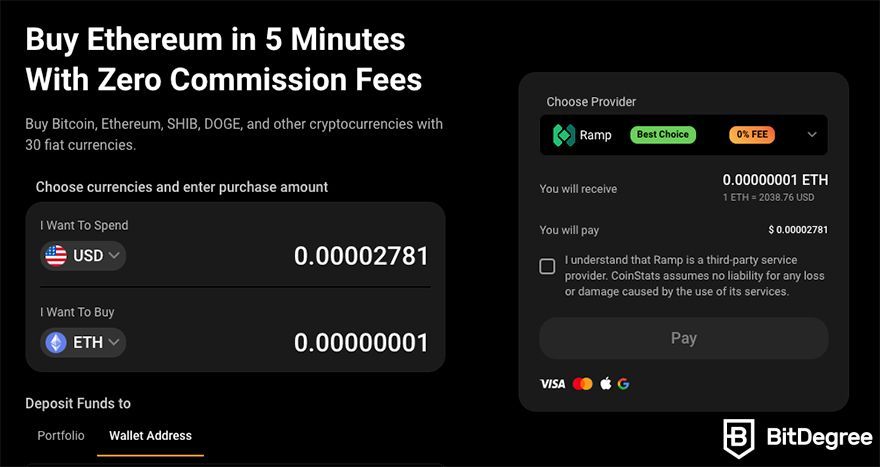
This feature, no matter the nature of a crypto tool or product, is always a welcome sight, be it a CoinStats wallet review or any other. It is no secret that one of the biggest struggles for a beginner is to get their first cryptocurrency. Crossing that chasm from fiat to crypto used to be an extremely complex chore, but thanks to protocols like the ones CoinStats is using, it is much easier and more pleasant.
Lastly, there is CoinStats Earn. Essentially, this feature opens the door to various DeFi staking and yield farming protocols, enabling users to leverage their crypto holdings and generate passive income. The platform boasts the potential for substantial returns, reaching up to 20%.

What sets CoinStats Earn apart is its commitment to simplicity and user-friendly functionality. Users benefit from a straightforward single-click experience, making the process of earning hassle-free and accessible to all. The platform prioritizes flexibility in earning, ensuring that users have control over their portfolios and can adapt their strategies to meet their financial goals.
Moreover, CoinStats Earn emphasizes low fees, providing users with a cost-effective way to engage in DeFi staking and yield farming. All in all, with this feature, you can make your crypto assets work for you efficiently and effortlessly.

Did you know?
All Crypto Exchanges may look similar to you but they're NOT all the same!
CoinStats Review: CONS
All that comes up must come down, and so is the case with my CoinStats review. While there are many elements to rave about, there is one shortcoming that I want to highlight – the limitations of the Basic account.
Basic Account is Pretty... Well, Basic
There are many exciting features that CoinStats supports, but sadly, its best features can only really be enjoyed by premium users. To put this into context within this CoinStats review, the platform has three tiers: Basic (which is free), Premium (which is a monthly subscription), and Team (where you have to inquire to discuss pricing).
This is not unusual in the slightest – in fact, there are many services that work in a similar way. However, what is disappointing is that the most important features are concealed behind its premium tier. Namely, its highly interconnective nature that allows for unlimited connected portfolios, in-depth analysis, and 1 million transactions being monitored.
![]()
This might leave you asking, what do Basic users receive? The answer is that they can connect 10 portfolios, and can view 1000 transactions within their free account. Now, don't get me wrong, this is not inherently bad. In fact, it's nice that there is a free account in the first place, which will likely work out very well for people who only invest in a handful of cryptos or use a small number of wallets and exchanges.
However, for any level of seasoned and varied user, the basic account will be rendered quite limiting, so they will have to gain access to the premium account. Speaking of which, what is CoinStats pricing?
CoinStats Pricing
Should the platform's pricing be praised in Coin Stats reviews? Let's see.
For starters, you already know the answer to the question, “is CoinStats free?” – if you go with the Basic plan, it is free. Speaking of the paid version, though, there are two pricing options for a Premium account. If you pay on a yearly basis, the price breaks down to $9.99 per month. If you want to pay one month at a time, on the other hand, it will cost you $15.99.
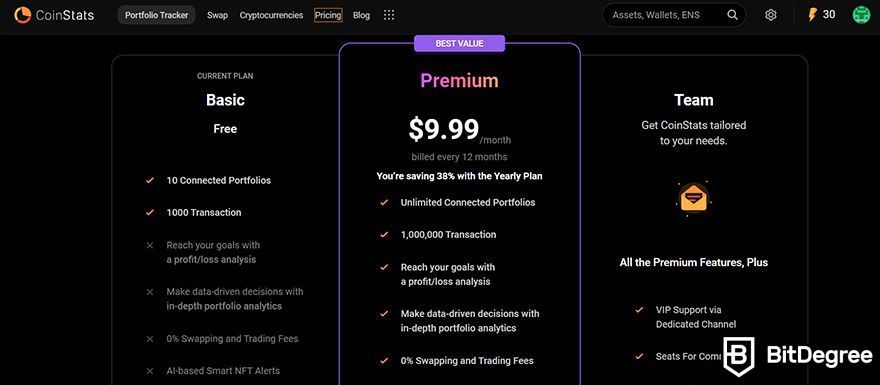
So, as you can see, the CoinStats pricing is pretty decent. Charging a maximum of $15.99 for the services offered is not exactly outlandish, as the company provides something truly high quality and useful to all.
The feature-deprived Basic plan might be a bit disappointing, but when it comes to pricing in the full spectrum of what CoinStats offer, it makes sense for rates to be where they are.
Plus, the option for teams is nice, as it encourages trading groups and cohorts to get into talks with the company and strike a good deal that suits all. It is always great to see platforms have this type of option ready and available.
How to Use CoinStats? (Mobile + Browser)
There is no better way to cement the information explored in this CoinStats app review than to apply it in the real world. So, let’s take a look at how to use CoinStats. I'll cover both CoinStats' browser and mobile version usage.
How to Sign Up on CoinStats?
Before we go to the "how to use CoinStats portfolio" part, let's discuss how to sign up on the platform. First off, let's see how it's done on the mobile app.
CoinStats Mobile App Sign Up
Step 1: Download the app to your mobile device (you can find it here). Once you open the app, click the "Get Started" button.

Step 2: You'll be asked several questions about yourself, namely, what brings you to CoinStats and what is your current crypto portfolio target value.

Step 3: Then, you'll be asked to connect the portfolios you want to track. So, this essentially is the sign up part (if you want to sign up with email, you can skip this step now and create an account once you set up the app). You can go with whichever you want (and you can connect more later). For the sake of this Coin Stats app review, I went with MetaMask.
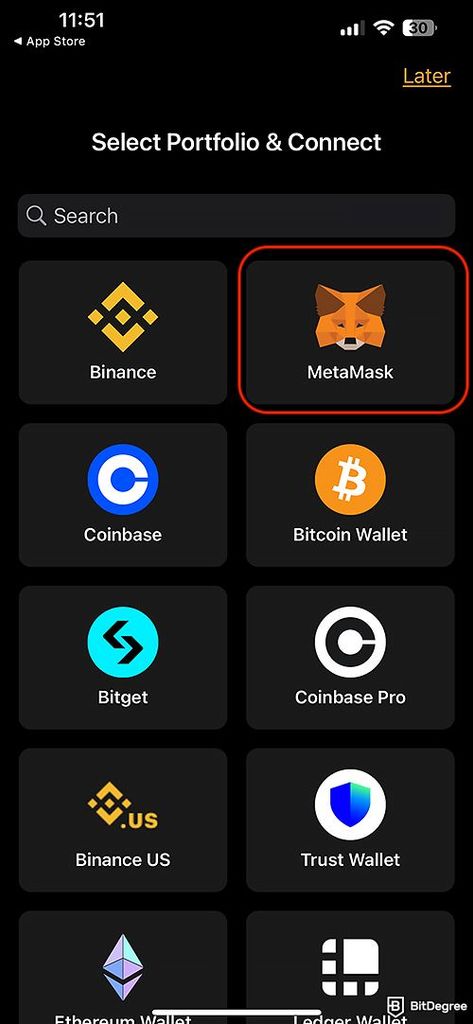
Make sure you have the MetaMask app installed and set up on your mobile device. If you do, once you click on "MetaMask", you'll be taken to the wallet, where you'll just have to click "Connect" and then "Sign".

Step 4: The next thing you'll be asked to do is enable notifications. I strongly suggest doing that, especially since the whole idea of a portfolio tracker is knowing about price changes and other important updates immediately when they happen.
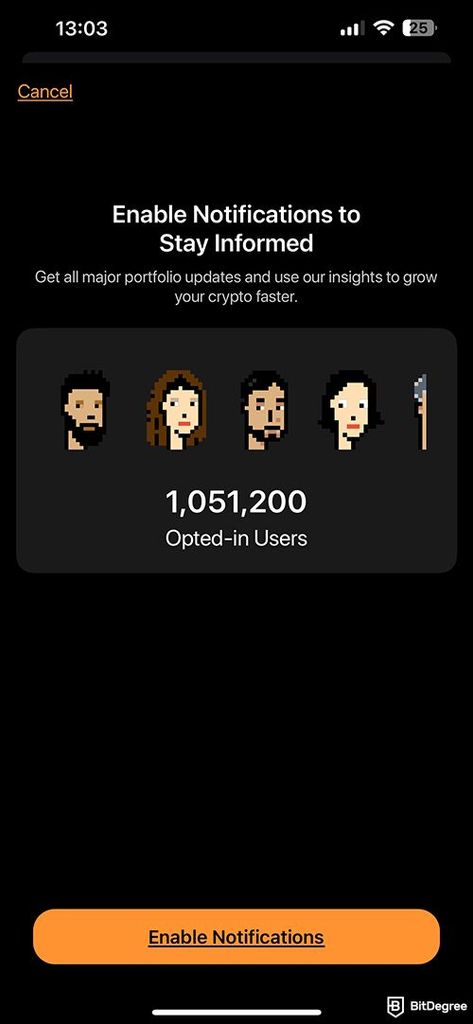
Once you pass this step, you'll be signed in to the CoinStats app. Then, you'll just have to connect all the portfolios you want to track, and you'll be all set.
With that out of the way, let's see how it's done via browser. Though it's definitely not much different.
CoinStats Browser Sign Up
Step 1: Head to the CoinStats website. At the top right corner, you'll see a button that says “Get Started”. Click on it.
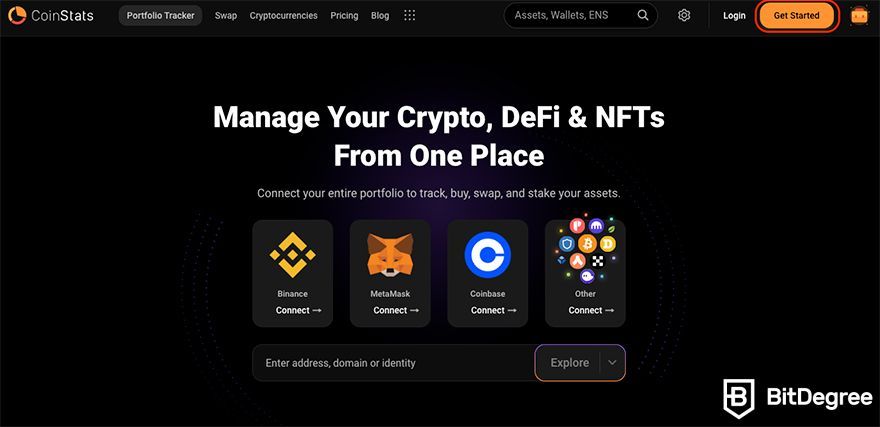
Step 2: A sign up box will pop up. You'll notice that you have a few options immediatelly – you can sign up with your email address, Coinbase account, social media account, or any range of different Web3 wallets. For the consistency sake, let's go over the process of signing up using MetaMask again. So, click on “Continue with Wallet”.
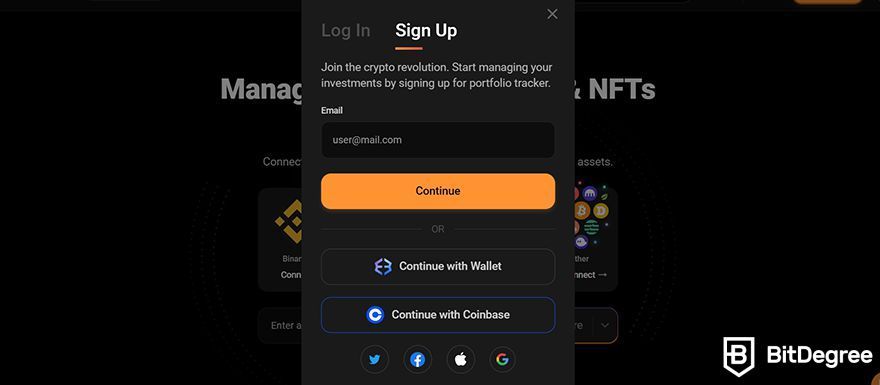
Step 3: You will be given four options of different wallets. This is not the full range that CoinStats fully connects to when you get to its actual services, but rather just a small list that can be used to make an account. Click on MetaMask.
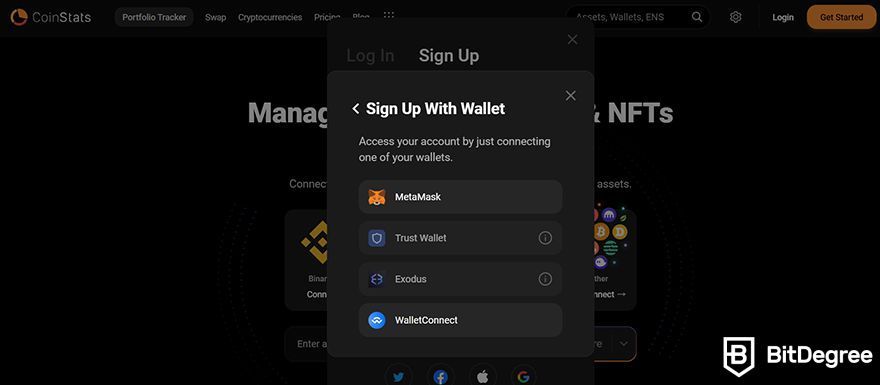
Step 4: You will now be asked to sign into MetaMask and accept the connection. Click “Connect”, and then sign a contract that officializes the connection. Do note that for the best experience, you should have a MetaMask wallet extension installed in your browser.

And that's it! Once you confirm the connection on your wallet you'll be signed in. Then, you just have to connect your wallet and exchange accounts to CoinStats to start tracking all your assets in one place. Speaking of tracking, let's talk about how to use CoinStats portfolio.
How to Use CoinStats Portfolio?
So, you've connected all your accounts to CoinStats, now what? How to navigate the platform? Don't worry, it's very intuitive.
Portfolios: On the browser, you can find and easily switch between all your connected portfolios using the very first button on your dashboard. It will be named based on the portfolio that's currently on display.
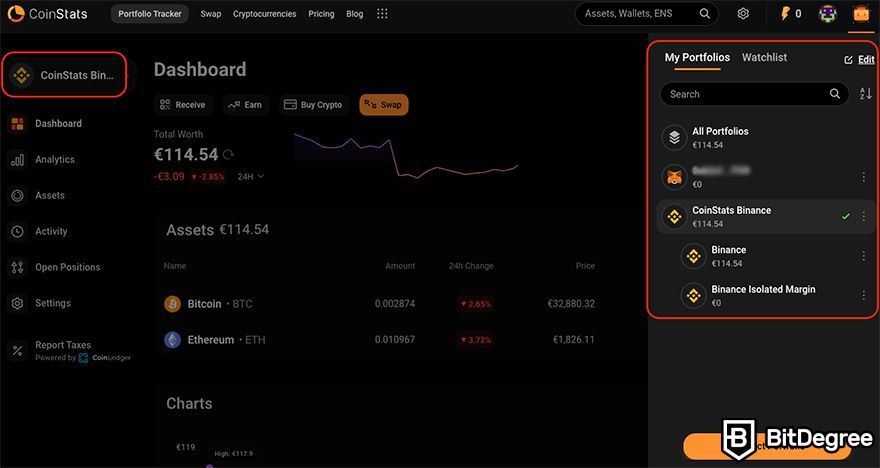
If you follow any other trader addresses in your Watchlist, this is also the place where you can access them.
Talking about the mobile app, when you're in the "Portfolio" tab, you can see the logos of your connected portfolios in the top right corner. Click on them and you'll be able to switch between these portfolios.

Dashboard: Now, on your browser version's dashboard, you'll be able to see three things. Firstly, you can see all your assets in that portfolio together with their prices, amount, price changes, and the total worth of your portfolio.
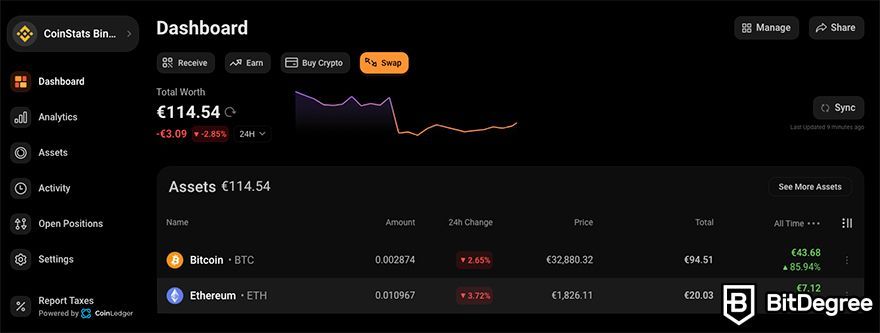
If you scroll down, you'll see the charts that portray what kind of assets (and how many) you have, as well as their price changes in a certain time period. If you want to see more charts, you can click on "See More Charts," but then you'll be taken to the "Analytics" tab, which I'll cover in a sec.
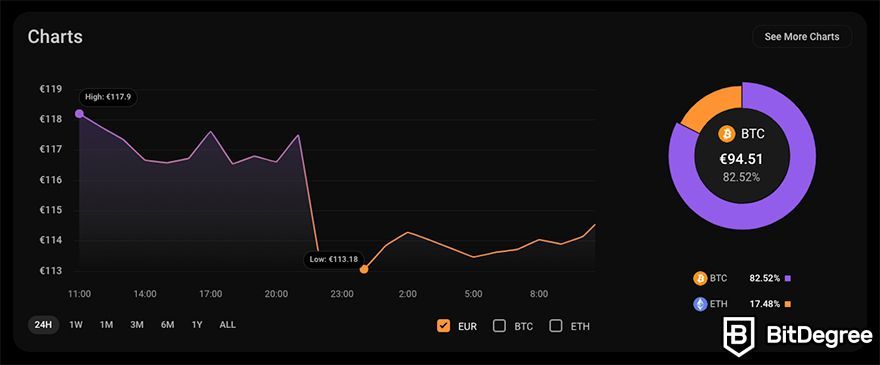
If you scroll down more, you'll see your portfolio activity – the assets you've received, sent, traded, etc. Of course, only the latest ones will appear here. If you want to see more, click "See More Activity" or just go to the "Activity" tab.
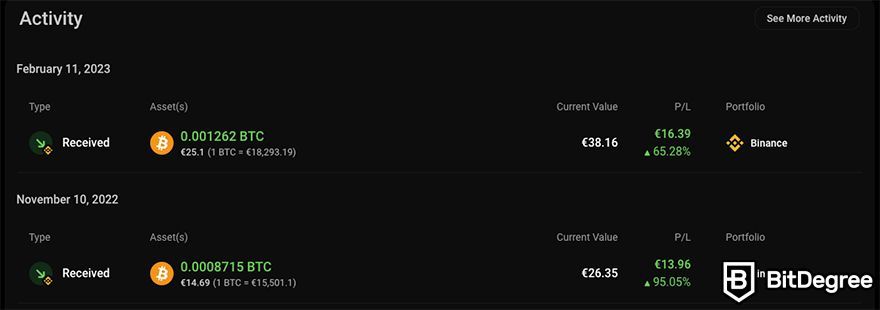
Overall, the dashboard is the place where you'll see all the information in a summarized manner. You can even customize it to display only the things you want to see there (charts, for example).
There is no such thing on the mobile app – you just go to the specific tabs you want to see.
Analytics: The charts you saw on your dashboard are just the tip of the iceberg when it comes to the charts you can find in your "Analytics" tab on the browser. For starters, you'll see stats about your top gainers, losers, top used exchanges, total deposits, and so on. Below, you'll also see your portfolio value chart.
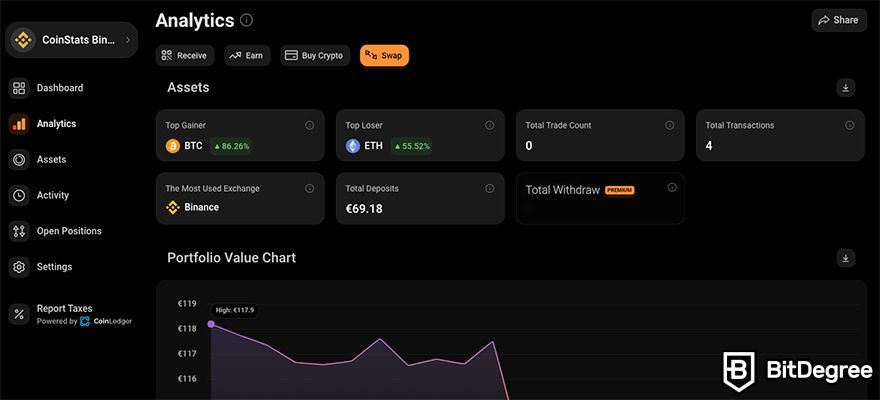
Then, once you scroll down, you'll see more charts, including a heatmap, a pie chart with your assets, as well as your asset allocation.
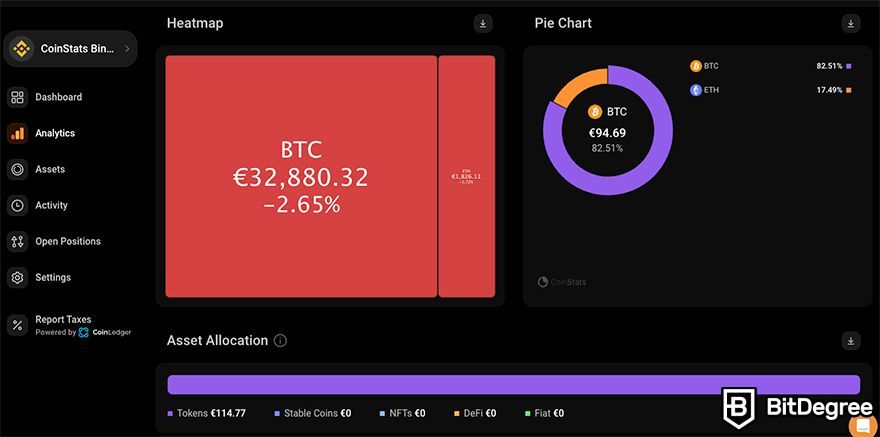
Below that, you'll see even more charts - daily P&L, cumulative P&L, and Portfolio vs Market. Though these can only be viewed by Premium users. Additionally, at the very end, you can also see your trading fees and chain activity.
When it comes to mobile app, you can access analytics tab by clicking on three dots next to the "Earn" button and then selecting "Analytics / Pie Chart".
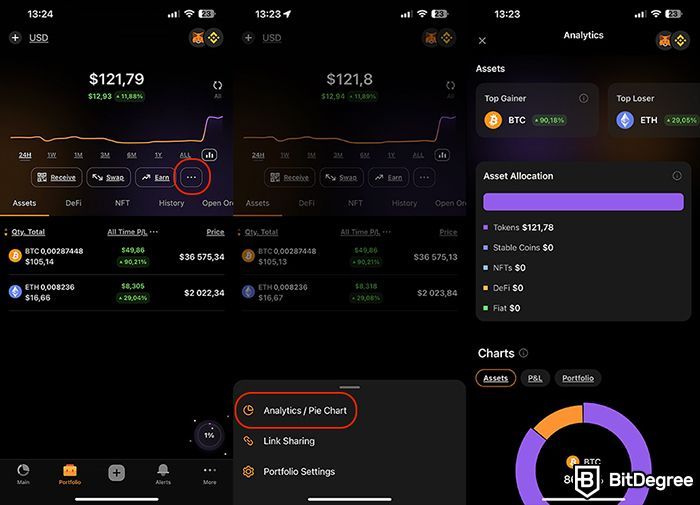
Assets: Now, the assets tab on the browser is the same as you can see on the dashboard. However, if you have a lot of assets, that's where you can see all of them, while on the dashboard, you'll see a limited amount.
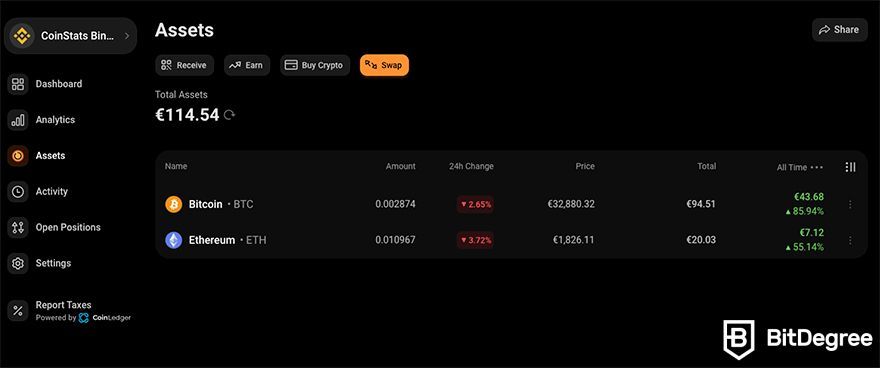
Talking about the mobile app, the assets tab is the very first thing you see when you go to the portfolio. You can easily switch to see your DeFi projects or NFTs as well.
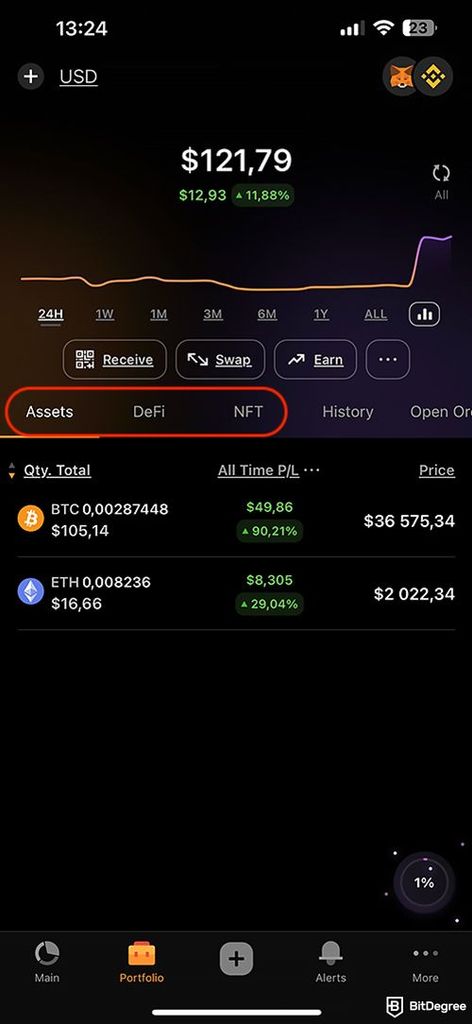
Activity: Again, just like with assets, you'll see the same info you can see on your CoinStats browser version's dashboard, apart from the fact that here you'll be able to access all activity information. Plus, you'll be able to filter it based on transaction type, date, and so on.

On the mobile app you have to go to the "History" tab to see your portfolio activity.
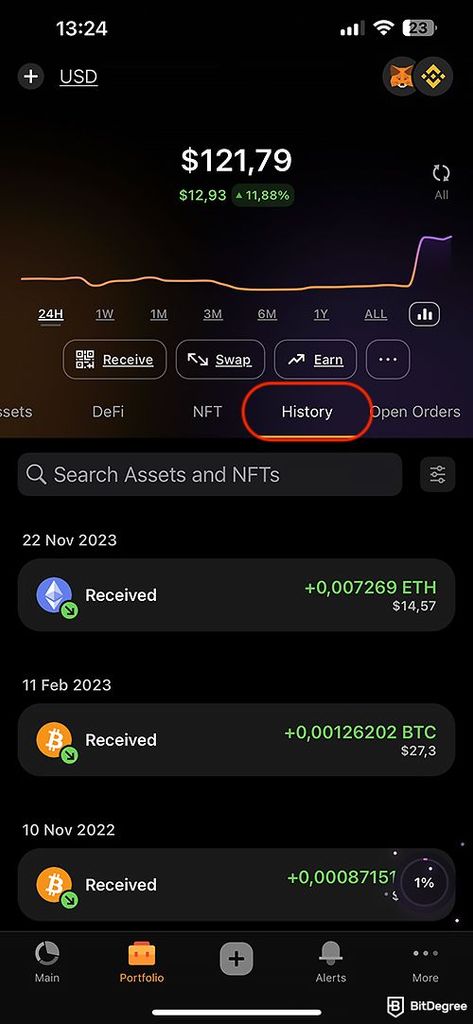
Open Positions: In this tab, you'll see your crypto investments. Let's say you are currently staking a certain portion of crypto in some protocol – that's where you'll be able to see information about it.
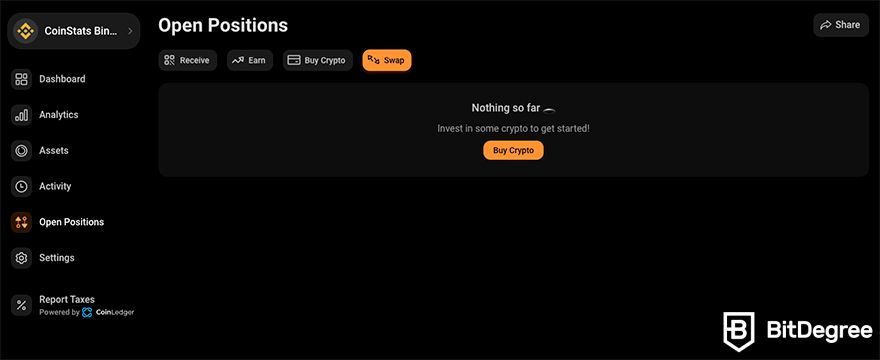
The same goes for the mobile app version, just click on the "Open Orders" tab.
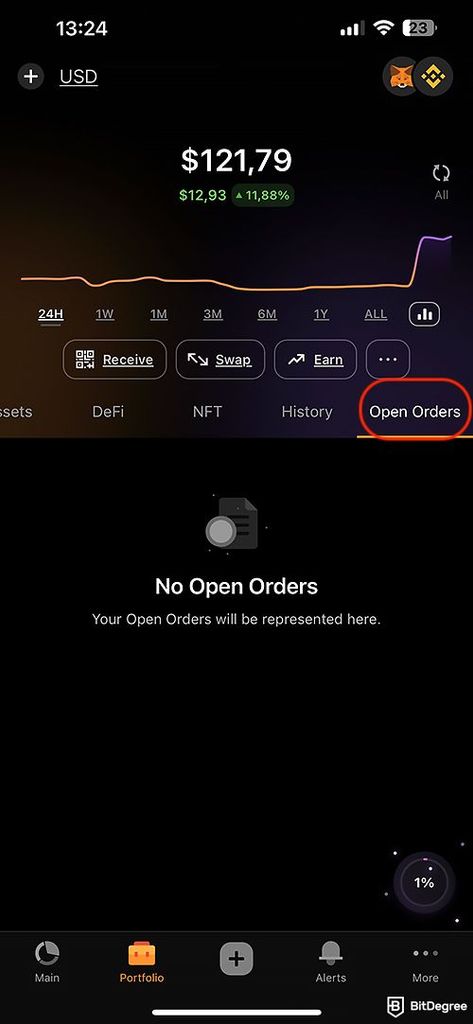
Settings: Well, it's quite obvious what this section is about. However, do note that you can find your coin blocklist here (hidden assets).
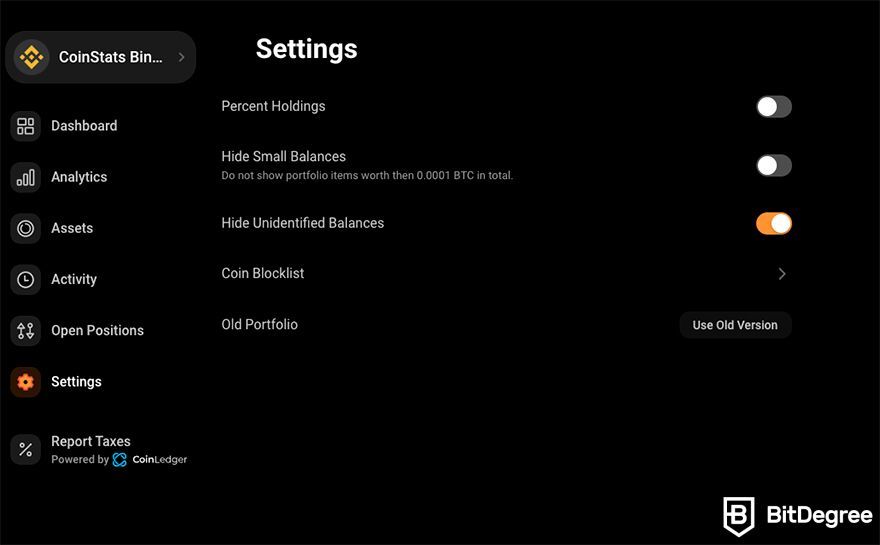
To access settings on the CoinStats mobile app, click "More" and then "Settings".

Report Taxes: This is quite a nifty feature – you can quickly generate a tax report for your crypto taxes. The report is generated in collaboration with CoinLedger.
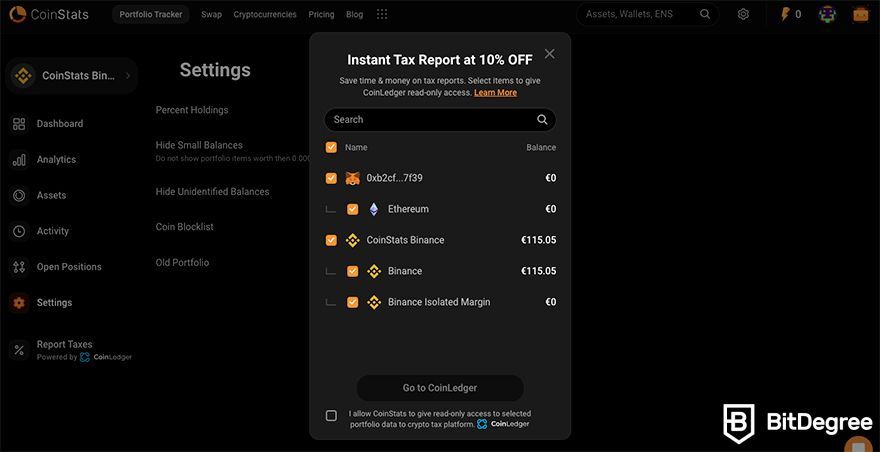
Considering the mobile app, just like with settings, click on "More," but this time click "Report Taxes".
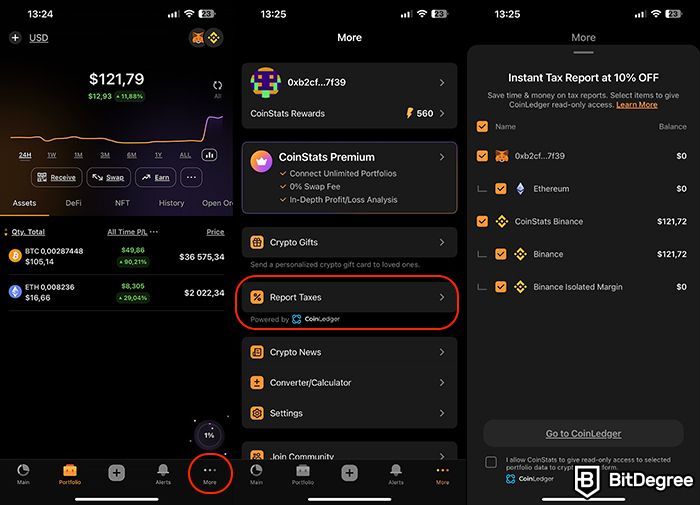
So, that's basically it when it comes to CoinStats portfolio navigation both on the browser version and the mobile app. Of course, there also is CoinStats' swap, earning tab, and fiat on- / off-ramp, which you can easily find on the menu at the top of the page on the browser (or under your portfolio's price chart on the app). These features are easy to use, so it's unlikely that you'll face any difficulties.

- Secure and reliable
- Accepts fiat currencies
- Lots of trading options
- Reputable exchange
- Accepts fiat currencies
- Offers various trading options

- Fiat currencies - accepted
- Simple to use
- Accepts only the most trustworthy cryptocurrencies
- A leading cryptocurrency exchange platform
- Best for beginner investors
- Accepts fiat currencies

- Beginner-friendly
- Secure
- Decent trading and withdrawal fees
Conclusions
To sum up my CoinStats review, I can say that it's a dynamic digital asset portfolio management tool. With its real-time tracking, insightful tools, and the possibility to track crypto, NFTs, and DeFi project from over 100 chains, it's clear why CoinStats stands strong in the portfolio tracking industry. Besides, it's very convenient to use, especially if you use the CoinStats mobile app, which you can download here.
However, it's more than just a portfolio tracker, as CoinStats allows users to swap, buy, sell, and store digital assets, as well as explore various earning opportunities. The only downside of the platform is that its Basic account (which is free) is quite limited. Nonetheless, I'd say that the CoinStats pricing for its Premium account is pretty reasonable.
So, whether you're an investor or a DeFi enthusiast, CoinStats proves to be a valuable companion on your crypto journey.
The content published on this website is not aimed to give any kind of financial, investment, trading, or any other form of advice. BitDegree.org does not endorse or suggest you to buy, sell or hold any kind of cryptocurrency. Before making financial investment decisions, do consult your financial advisor.
Scientific References
1. F. S. Lhabitant: 'Portfolio Diversification';
2. P. Lafourcade, M. Lombard-Platet: 'About Blockchain Interoperability'.






